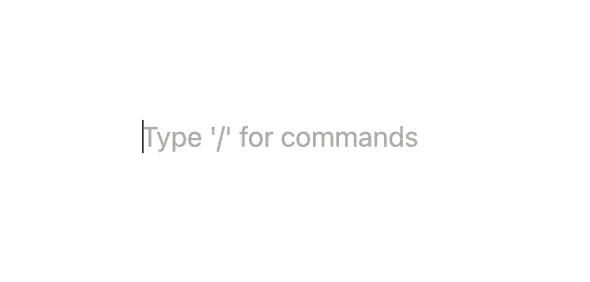Slate js - How to render placeholders per line
May 18, 2021
If you’re building a text editing interface, there’s a good chance you want to render a placeholder for empty lines/blocks to indicate a keyboard shortcut. Here’s how that looks in notion:
In this tutorial I’ll show you how to do this using Slate.js decorators.
Setting up
If you haven’t yet, [create a new react app] and install slate, slate-history and slate-react.
npx create-react-app my-app
cd my-app
npm install slate slate-react slate-history --save
npm start # this will start your appUse this boilerplate for a basic slate editor.
import { createEditor } from "slate";
import { withHistory } from "slate-history";
import { Editable, Slate, withReact } from "slate-react";
function MyEditor() {
const editor = useMemo<ReactEditor>(() => withHistory(withReact(createEditor())) , [])
const [value, setValue] = useState<Node[]>([
{
children: [{
text: "Hello World"
}]
},
]);
return <div>
<input type="text" />
<Slate editor={editor} onChange={setValue} value={value}>
<Editable />
</Slate>
</div>
}Don’t forget to mount MyEditor in your root component (in create-react-app that’d be in src/index.tsx)
Use decorate to decorate empty lines
Decoration is a slate api for modifying slate.js nodes before they are rendered. Without further ado, here’s the code:
<Editable
decorate={([node, path]) => {
if (editor.selection != null) {
if (
!Editor.isEditor(node) &&
Editor.string(editor, [path[0]]) === "" &&
Range.includes(editor.selection, path) &&
Range.isCollapsed(editor.selection)
) {
return [
{
...editor.selection,
placeholder: true,
},
];
}
}
return [];
}}
/>Let’s break this down. We want to decorate nodes with placeholder: true when the following conditions are met:
- The current node is not the Editor node:
Editor.isEditor() - The current root node is empty:
Editor.string(editor, [path[0]]) === "" - Our selection overlaps with the path our node is on:
Range.includes(editor.selection, path) - Our selection is collapsed:
Range.isCollapsed(editor.selection)
The decorate method is a prop on Editable component and always has to return an array, which is empty when no decorations are produced.
Rendering the placeholder
We use the renderLeaf prop to render our placeholder since decorations are only applied to leaves:
<Editable
decorate={/* the decorate method we defined above, excluded for brevity */}
renderLeaf={(props) => {
if (props.leaf.placeholder) {
return (
<>
<DefaultLeaf {...props} />
<span
style={{ opacity: 0.3, position: "absolute", top: 0 }}
contentEditable={false}
>
Type / to open menu
</span>
</>
);
}
return <DefaultLeaf
{...props}
/>
}}
/>Pretty simple. If props.leaf.placeholder is true we return the DefaultLeaf component alongside a span that looks like a placeholder. Don’t forget to set contentEditable to false for this span, so slate does not try to handle user events that are emitted from the element (which usually causes issues).
Voilà, it’s a wrap. The entire working code is available on my slate-patterns repository. Thanks for reading 👍
